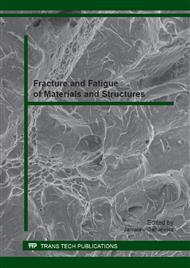p.207
p.213
p.219
p.225
p.231
p.237
p.243
p.249
p.255
Effect of the Exponent in the Description of Wöhler Fatigue Diagram on the Results of Calculations of Fatigue Life
Abstract:
The paper presents issues concerning the calculation of fatigue life under programmable load. Aim of this study is to analyze the sensitivity of the calculation method based on the variation of the exponent m used in the description of Wöhler fatigue chart. Arbitrary adoption of the recommendations contained in the FITNET procedures in fatigue module (the path 2b for normal stress) for the value of the exponent m = 5 can lead to significant differences in the calculation of fatigue life. This is due to the fact that the value of the exponent m obtained by experimental test of constructional steels and alloy is in within wide limits of variation from 3 to 30 with mean value in excess of 5. Based on the results of the fatigue life calculations for steel C45 and X5CrNi18-10 (1.4301) is noticeable a significant impact of exponent m on the fatigue life. This effect depends on the strain value in the load spectrum and increases with the increase of the maximum amplitude of stresses in the program Sa max.
Info:
Periodical:
Pages:
231-236
Citation:
Online since:
January 2014
Authors:
Price:
Сopyright:
© 2014 Trans Tech Publications Ltd. All Rights Reserved
Share:
Citation:


